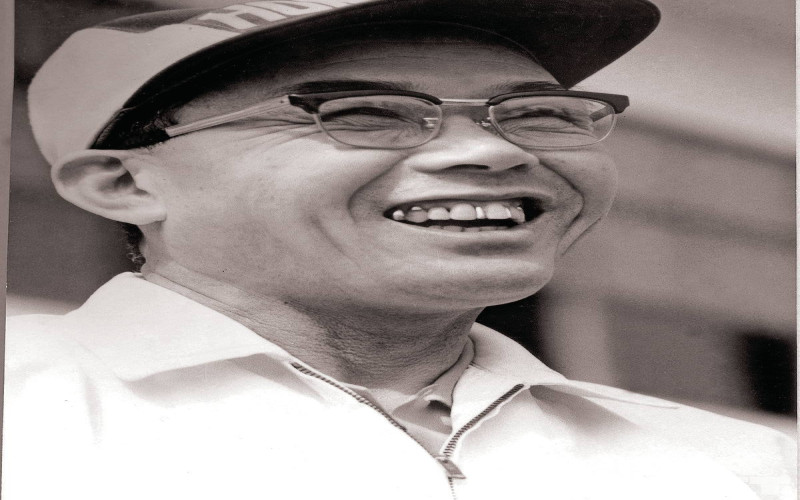
In 1922, a 15 year old boy shows up for his first day at work at a small auto repair shop in Tokyo, Japan.
The owner who questioned if the boy was even meant for this type of business assigned him to clean the workshop and look after his child instead.
At the time, nobody thought much of it, neither did they care, but only because they had no idea who this kid would eventually become.
Fast forward a few decades, and that boy Soichiro Honda was now competing with some of the. Biggest car brands in the world while also owning the largest motorbike manufacturer.
This is the story of how one poor Japanese boy went from babysitting children to building the multibillion dollar brand Honda Motors.
The story begins in 1906 in a small poverty ridden village called Tenryu Shizuoka at the foot of Mount Fuji. It was there that Guiher Honda and his wife welcomed their first son, Soichiro Honda.
Soichiro's father was a local blacksmith from the village who also fixed bicycles on the side while his mother was an accomplished Weaver raised in difficult economic situations, Soichiro lost five of his siblings, growing up due to health issues.
When Soichiro was eight years old, he was going about his normal routine in the neighborhood when he heard a strange rumble that grabbed his attention.
He followed the sound until he came across a big piece of strange machinery rolling along on four wheels.
This machine was a Ford Model T and Soichiro was left captivated by what he had just witnessed.
"It was the first car I saw. What a thrill. I could not understand how it could move under its own power and when it had driven past me without even thinking why. I found myself chasing it down the road as hard as I could run," said Soichiro Honda.
This experience left a mark in his life that would forever change the way he would engage with machines.
He learned how to wet the blades of the farm machinery and repair bicycles.
He was fascinated by all kinds of engines and motors, but Soichiro hated the idea of going to school and instead of pursuing a proper education, he spent the majority of his childhood helping his father with his bicycle repair business.
His lack of interest in school affected his grades so terribly that he used some rubber that he found.
To forge his family's stamp on his grade reports. That way his father wouldn't need to sign the paper and see his grades.
Eventually he got caught and his father punished him by making him kneel on his knees for an entire day without lunch.
In 1922, Soichiro came across a magazine ad for a Tokyo based automobile servicing company called Art Shokai.
He reasoned that since the company was one of the most popular motorcar services in the city, they might be in need of new workers, so he wrote a letter to art Shokai inquiring about a job and luckily enough, he received a positive reply.
So, at the age of 15, Soichiro dropped out of school, left home and headed for Tokyo in pursuit of his dreams. When Soichiro got to Tokyo, he was overwhelmed to see how fast and different city life was compared to the village he had come from.
When Soichiro arrived, the shop's owner, Yuzo Sakakibara, had a job already prepared for him.
He was to babysit the owner's child. Soichiro was disappointed to find that over the next few months, he wasn't making any money and the only work tasks.
He was assigned was to carry a baby wrapped around on his back.
The only thing that made Soichiro stay was the shame of returning home, a failure and facing his parents.
As time went by, the owner couldn't keep up with the high demand of his automobile business, so he finally pulled Soichiro in to help him out.
Even though Soichiro started out doing menial tasks, he gradually climbed his way up until he became a trusted mechanic at the company.
His talent and dedication eventually caught the attention of the owner, who decided to take Little Soichiro.
Under his wing and teach him not only mechanical repairs, but the business side of the company as well.
Although sakakibara's repair work included both automobiles and bicycles, cars were not as popular then as they are today.
Not only were automobiles a luxury that only people of the upper class could afford, but most of the automobiles around at the time were foreign, made through his work.
Soichiro quickly became familiar with a wide range of automobiles, including Lincolns, Mercedes, Daimlers and even various motorcycles that were brought into the workshop.
Soichiro poured everything he had into expanding his knowledge and understanding of his craft.
It was through this company that Soichiro was also introduced to the world of Motorsports around this time.
Motorsports were quickly gaining popularity around Europe, America, and even Japan, and in 1923, Sakakibara himself began to build racing cars with the help of his workers, including Soichiro. Their first model was the art Daimler builtu using a second hand Daimler engine. And their second model was the Curtis.
The Curtis was made using another second hand engine from an American Curtis biplane placed on the chassis of another American car, the Mitchell.
This car would go on to race in the 5th Japanese Motor Car Championship in 1924, taking a stunning first position with Sakakibara's brother as driver, and Soichiro as the accompanying engineer. It was a special experience for the 17 year old boy and from then on, motor Sports became his religion.
In 1926, Soichiro was drafted for military service but didn't pass the medical exams as they revealed that he wasbcolorblind.
Thus, he was excused from the army and was able to keep working at Art Shokai by 1928. Yuzo Sakakibara wanted to expand his business and decided to open a branch of art Shokai in Hamamatsu.
He believed there was no better. Then to leave in charge than his young apprentice, and at the age of 21, Soichiro was called upon to run the new branch.
However, Soichiro's repair shop struggled during the first year, largely because people didn't want to entrust their cars with someone so new and so young.
So Trudeau had to live off the scraps that other repair shops cast aside. Still, the young man used all the knowledge and skill he had acquired over the years, and in time he successfully managed to grow his business.
Soichiro remained the president of the company until retirement in 1973; then, he remained the director and was appointed the supreme advisor in 1983.
In his biography, he had recalled that he was thrilled by the first car that he saw as an eight-year-old and that he could never forget the smell of oil it gave off. He claimed that it was then, as a toddler, that he had dreamed of manufacturing a car himself someday.
The Japanese engineer and industrialist founded Tokai Seiki to produce piston rings for Toyota in 1937. He passed away on August 5, 1991, from liver failure.
By Fridah Wangechi | 1 year ago
By Fridah Wangechi | 1 year ago
By Ezra Manyibe | 1 week ago
By Fridah Wangechi | 1 year ago
KeNHA Issues Advisory on State of Athi River Bridge
Ezra Manyibe | 14 hours ago
ODM Postpones Grassroots Elections Indefinitely
Ezra Manyibe | 17 hours ago

Joy Waweru | 1 year ago